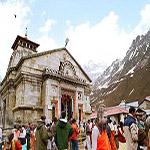Kedarnath is one of the twelve Jyotirlingas. This ancient and magnificient temple is located in the Rudra Himalaya range. This temple, over a thousand years old is built of massive stone slabs over a large rectangular platform. Ascending through the large gray steps leading to the holy sanctums we find inscriptions in Pali on the steps. The present temple was built by Adi Shankaracharya.The inner walls of the temple sanctum are adorned with figures of various deities and scenes from mythology. Outside the temple door a large statue of the Nandi Bull stands as guard. A conical rock formation inside the temple is worshipped as Lord Shiva in his Sadashiva form. The temple, believed to be very ancient, has been continually renovated over the centuries. It is situated at an altitude of 3,581 mt. it is a 14 km trek from gaurikund. At the approach of winters in the month of November, the holy statue of Lord Shiva, is carried down from Garhwal (Kedarkhand) to Ukhimath, and is reinstated at Kedarnath, in the first week of May. It is at this time, that the doors of the temple are Kept open to pilgrims, who flock from all parts of India, for a holy pilgrimage. The shrine closes on the first day of Kartik and reopens in Vaishakh every year. During its closure the shrine is submerged in snow and worship is performed at Ukhimath.

The shrine of Kedarnath is very scenically placed, and is surrounded by lofty, snow covered mountains, and grassy meadows covering the valleys. Immediately behind the temple, is the high Keadardome peak, which can be sighted from great distances. The sight of the temple and the peak with its perpetual snows is simply an enthralling.
Significance :The lingam at Kedarnath, unlike its usual form, is pyramidal and is regarded as one of the 12 jyotirlingas. The pandavas after having won over the kauravas in the Kurukshetra war, felt guilty of having killed their own brothers & sought the blessings of Lord Shiva for redemption. He eluded them repeatedly & while fleeing took refuge at Kedarnath in the form of a bull. On being followed he dived in to the ground, leaving his hump on the surface. The remaining portions of Lord Shiva appeared at four places and are worshiped there as his manifestations. The arms appeared at Tunganath, the face at Rudranath, the belly at Madmaheshwar & his locks at Kalpeshwar. Kedarnath including these four shrines is treated as Panch Kedar. Pilgrims traditionally first visit Yamunotri and Gangotri and bring with them the holy waters from the sources of the rivers Yamuna and Ganga and offer abhishekams to Kedareshwara. The traditional pilgrim route is Haridwar – Rishikesh – Devaprayag – Tehri – Dharasu – Yamunotri – Uttar Kashi – Gangotri – Triyugnarayan – Gowrikund and Kedarnath. Alternatively, the route to Kedar from Rishikesh is via Devprayag, Srinagar, Rudraprayag and Ukhimath. Near Kedarnath is the source of the river Mandakini. Mandakini joins Alakananda at Rudraprayag.
Temple Opening Time :As per the tradition decided by Lord Brahma the temple would be open for six months i.e from Hindu calender month Vaishaka to Karthik for darshan to common people. For the remaining six months i.e from Margashsish to Chaitra the temple would be closed for darshan to common people as it is Devas turn for Lord’s darshan.
Travel Info : Private Hotels and Dharamshala. Temple Committee Guest House.
GMVN Tourist Bungalow, Modi Bhavan, behind the temple.Punjab Sindh, next to the Post office. UP Tourism Accommodation Tourist Rest House, GMVN. Ph.: (01372-86)6210
Where to Eat : Local eateries/dhabas which offer only vegetarian food. Non-vegetarian food and alcoholic drinks are prohibited.
Accessibility:Rail Nearest Railway station is Rishikesh.
Location : Kedarnath
State : Uttaranchal